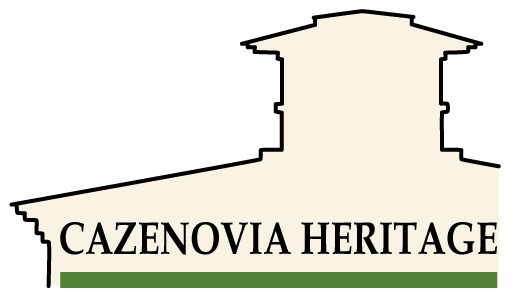GLOSSARY OF TERMS
Note: The following are definitions taken from the U.S. Department of Interior standards, other historic preservation organizations, and local laws. They are intended to provide a general baseline of understanding and communication. As such, the definitions may or may not be the same as those defined within a specific zoning law or other legislation. And, there may be distinctions between the Village and Town definitions of such terms.
Adaptive Re-Use: The process of re-using an old building/structure, object, or site for purposes other than for which it what originally built. Example: re-use of a residence as an office building.
Alteration: Any act or process that changes one or more of the historic, cultural, architectural, or archeological features of a structure, building, site, area, or object, including but not limited to the erection, construction, reconstruction, or relocation of any property, structure or object, or any part thereof, or land-altering activities.
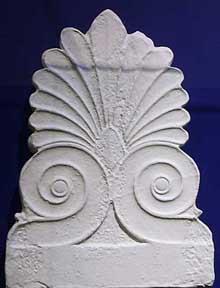
Anthemion: an ornamental design of alternating motifs resembling clusters of narrow leaves or lotus palmette petals
Appropriate: Especially suitable or compatible.
Building: A building created principally to shelter any form of human activity, such as a house, church, hotel, library, store, and other similar buildings. Building may also be used to refer to a historically and functionally related unit, such as a courthouse and jail, or a house and barn. Caz Examples: Residences, Schoolhouses, hop houses
Compatible: In harmony with the location, context, setting, and historic character.
Contemporary: Reflecting the characteristics of the current period; that a building, structure, or detail was constructed in the current period.
Context: The conceptual framework or physical surroundings for a building or site.
Contributing: A classification applied to an area, building/property, structure, site, or object signifying that it contributes generally to the qualities that give the area or “district" its historic, cultural, architectural, or archeological significance as embodied in the criteria for designating the district. A resource may be contributing even if it has been altered as long as it maintains the character defined for the district.
District: An identifiable area with definable boundaries and in which a considerable number of the properties, structures, sites, landmarks, or objects have a high degree of historic, cultural, architectural, or archeological significance and integrity. District is often used to mean Historic District, such as the Village Historic Business District, and in other communities where such districts have been so designated locally by ordinance or by the U.S. Department of Interior.

Griffin: In architectural decoration, the griffin is usually represented as a four-footed beast with wings and the head of an eagle
Historic Integrity: The ability of a resource to convey its significance; the retention of sufficient aspects of location, design, setting, workmanship, materials, feeling, or association for a resource to convey its historic significance.
Historic Material: Material from which the building was originally built.
Historic Preservation: According to the National Historic Preservation Act, historic preservation includes the identification, evaluation, recordation, documentation, curation, acquisition, protection, management rehabilitation, restoration, stabilization, maintenance, research, interpretation, conservation, education, and training regarding the foregoing activities or a combination of the foregoing activities.
Historic Significance: Determines the why, where, and when a property is important; Is the importance of a resource with regard to its history, architecture, engineering, or the culture of a community, state, or nation.
Integrity: Adherence to a high level of historical, architectural accuracy and is relatively unchanged since originally constructed; the authenticity of a resource's historic identity, evidenced by the survival of physical characteristics that existed during the property's historic or prehistoric period. The Secretary of the Interior recognizes a resource's integrity though seven aspects or qualities: location, design, setting, materials, workmanship, feeling, and association.
Local Landmark/Locally Significant Resource: A resource that has a high degree of historic, cultural, architectural or archeological significance to the community, and which may be designated as such by a governing body.
Maintain: To keep in an existing state of preservation or repair.
Mitigation: The ability to lessen a negative impact.
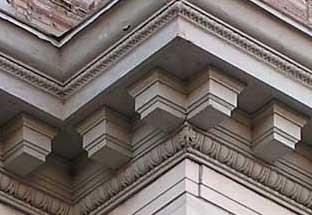
Modillion: An ornate bracket, more horizontal in shape and less imposing than a corbel. They are often seen underneath a cornice which is helps to support. Modillions are more elaborate than dentils.
Mothball (Stabilization): Temporary measures to protect a resource from the weather, as well as to secure it from vandalism; the act or process of applying measures essential to the maintenance of a deteriorated building, so as to establish structural soundness.
Non-contributing: A designation applied to a resource indicating that it is not a representation of the qualities that give a district it historic, cultural, architectural, or archeological significance as embodied within the criteria for designating that district.
Object: The term object is used to distinguish from buildings and structures those constructions that are primarily artistic in nature or are relatively small in scale and simply constructed. Although it may be (by nature or design) movable, the object is typically associated with a specific setting or environment. Examples: statue, sculpture, monuments, property boundary markers, fountains. Caz Example: Caz watering troughs; waterwheel in New Woodstock.

Pergola: an archway usually in a garden or park consisting of a framework covered with trained climbing or trailing plants, typically consisting of four columns or posts to define a space, topped with beams and open rafters
Preservation: The act or process of applying measures necessary to sustain the existing form, integrity, and materials of an historic resource. Preservation can include the limited and sensitive upgrading of mechanical, electrical, and plumbing systems and other code-required work to make properties functional.
Proportion: The ratio of one dimension to another; generally used to describe the relationship between the height and width of a door or window. The proportions of an entire building are often referred to in the context of scale, the relationship between the size of the building and the size of a person.
Protection: the act or process of measures designed to affect the physical condition of the property by defending or guarding it from deterioration, loss, or attack; the protective measures may be temporary or permanent.
Reconstruction: The act or process of depicting, by means of new construction the form, features, and detailing of a non-surviving site, landscape, building, structure, or object for the purpose of replicating its original appearance at a specific period of time and in its historic location.
Refurbish: To renovate or make clean, fresh, or functional again through a process of major maintenance or minor repair.
Rehabilitation: The process of making possible a use for a property through repair, alterations, and additions while preserving those portions or features which convey its historical, cultural, or architectural values.
Remodel: To change a building without regard to its distinctive features or style. Often calls for changing the appearance of a structure/building by removing or covering original details and substituting new materials and forms.
Renovate: To repair a structure/building and make it useful again. Historic preservationists prefer to use the term “rehabilitate" as the latter incorporates retention of historic architectural or cultural features.
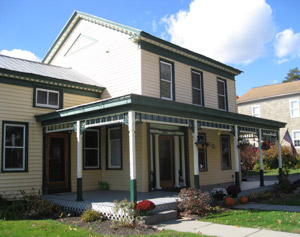
Repair: Any change to a resource that is not an alteration, construction, relocation, or demolition.
Replication: Constructing a building so that it is an exact replica or imitation of an historic architectural style or period.
Restore: The act or process of accurately depicting the form, features, and character of a property as it appeared at a particular period of time by means of the removal of features from other periods in its history and reconstruction of missing features from the restoration period.
Resource (Cultural Resource, Historic Resource):A collective term generally defined as physical evidence or place of past human activity and includes building, structure, site, or object of significance in the history, architecture, culture, and/or archeology at the local, state, or national level.
Scale: A term used to define the proportions of a building in relation to its surroundings or the proportional elements that demonstrate the size, materials, and style of buildings.
Significant: Having important associations within the contexts of architecture, history, and culture. Meeting the criteria as established by the Department of the Interior and/or local determination.
Site: The location of a significant event, a prehistoric or historic occupation or activity; or a building or structure, whether standing or ruined, or vanished, where the location itself possesses historic, cultural, or archeological value. May include landscapes or viewsheds having special historical or aesthetic interest or community value. Caz Examples: Green St. Parade Ground; Cemeteries; New Woodstock WPA forested area; Caz Train roundhouse @ Rtes 92/20; Cazenovia Viewsheds identified in Comprehensive Plan
Stabilization: The act or process of applying measures to sustain the existing form, integrity, and material of a building or structure, and the existing form and vegetative cover of a site.
Streetscape: The combination of building facades, sidewalks, street furntiture, etc that define the street.
Structure: The term structure is used to distinguish from buildings those functional constructions made usually for purposes other than creating human shelter. Includes anything constructed or erected, the use of which requires directly or indirectly a permanent location on or in the ground. Examples include bridges, tunnels, dams, railroad grades, railroad cars, signs, roadways, walks/steps, windmills, railroad and trolley cars, and earthworks. Caz Examples: Railroad tunnel; Chittenango creek bridges; Turnstile in New Woodstock. Industrial remains: Cedar Grove, Bingley, Belmont powder keg factory. Roadways/Railroads: Petersboro Turnpike, Cherry Valley turnpike, etc.
Style: A type of architecture distinguished by special characteristics of structure and ornament and often related in time; also, a general quality of a distinctive character.
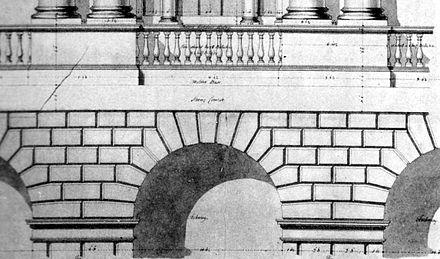
Voussoir: a wedge-shaped or tapered stone used to construct an arch
Want to add another term? Email us at info@cazheritage.org
Cazenovia Heritage
P.O. Box 103 • Cazenovia, NY 13035
EMAIL info@cazheritage.org
©2024 Cazenovia Heritage and Matai House Studio (web design)
